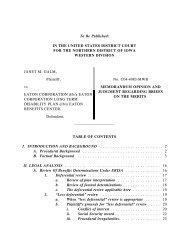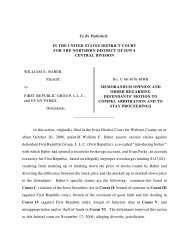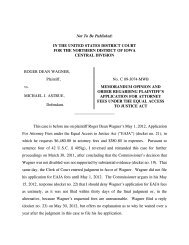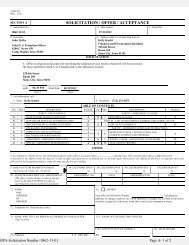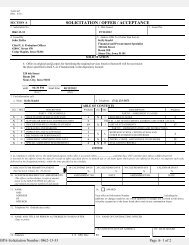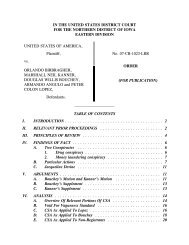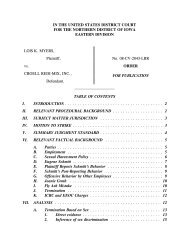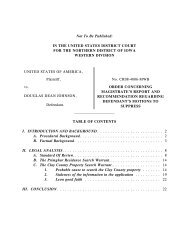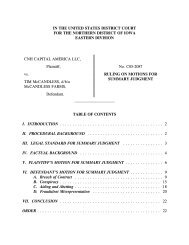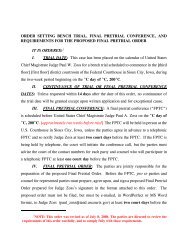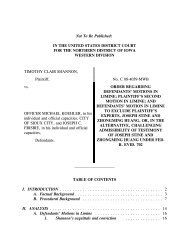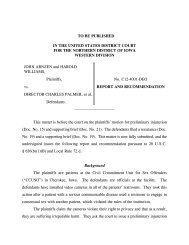in the united states district court - Northern District of Iowa
in the united states district court - Northern District of Iowa
in the united states district court - Northern District of Iowa
Create successful ePaper yourself
Turn your PDF publications into a flip-book with our unique Google optimized e-Paper software.
IN THE UNITED STATES DISTRICT COURT<br />
FOR THE NORTHERN DISTRICT OF IOWA<br />
CEDAR RAPIDS DIVISION<br />
UNITED STATES OF AMERICA,<br />
Pla<strong>in</strong>tiff,<br />
Case No. CR07-0050<br />
vs.<br />
REPORT AND RECOMMENDATION<br />
ROBERT EARL COLE, JR.,<br />
Defendant.<br />
____________________<br />
I. INTRODUCTION ....................................... 1<br />
II. RELEVANT FACTS ..................................... 2<br />
III. ANALYSIS ........................................... 5<br />
A. Was Defendant Unlawfully Seized when Required<br />
to Exit <strong>the</strong> Vehicle? ................................. 5<br />
B. Was Defendant’s Consent to Giv<strong>in</strong>g a Ur<strong>in</strong>e Sample Voluntary? .... 9<br />
C. Does <strong>the</strong> Inevitable Discovery Exception to <strong>the</strong><br />
Exclusionary Rule Apply? ............................ 11<br />
IV. SUMMARY .......................................... 13<br />
V. RECOMMENDATION .................................. 14<br />
I. INTRODUCTION<br />
On <strong>the</strong> 7th day <strong>of</strong> August 2007, this matter came on for hear<strong>in</strong>g on <strong>the</strong> Motion to<br />
Suppress (docket number 12) filed by <strong>the</strong> Defendant on July 25, 2007. The Government<br />
was represented by Assistant United States Attorney Stephanie Rose. Defendant Robert<br />
Earl Cole, Jr., appeared personally and was represented by his attorney, Clemens A.<br />
Erdahl. The parties were given until August 10, 2007, to file supplemental briefs.
II. RELEVANT FACTS<br />
Act<strong>in</strong>g on compla<strong>in</strong>ts <strong>of</strong> suspected drug activity, <strong>of</strong>ficers <strong>of</strong> <strong>the</strong> Cedar Rapids Police<br />
Department conducted surveillance on a residence at 1507 Wash<strong>in</strong>gton Avenue S.E. <strong>in</strong><br />
Cedar Rapids. Investigator Brian Freeberg testified that dur<strong>in</strong>g <strong>the</strong> afternoon <strong>of</strong> March 20,<br />
2007, he and his partner, Investigator Dunl<strong>in</strong>ger, observed two black males stand<strong>in</strong>g for<br />
an extended period <strong>in</strong> front <strong>of</strong> <strong>the</strong> subject property. One <strong>of</strong> <strong>the</strong> <strong>in</strong>dividuals was stand<strong>in</strong>g<br />
by <strong>the</strong> sidewalk, while <strong>the</strong> o<strong>the</strong>r stood up by <strong>the</strong> porch. Accord<strong>in</strong>g to Freeberg, <strong>the</strong><br />
subjects were not talk<strong>in</strong>g to each o<strong>the</strong>r, but were <strong>in</strong>stead stand<strong>in</strong>g and look<strong>in</strong>g around.<br />
Investigator Freeberg testified that while he was observ<strong>in</strong>g, “a few people”<br />
approached <strong>the</strong> property and would go between <strong>the</strong> houses with one <strong>of</strong> <strong>the</strong> persons stand<strong>in</strong>g<br />
<strong>the</strong>re. After a short period <strong>of</strong> time, <strong>the</strong>y would come out and <strong>the</strong> visit<strong>in</strong>g <strong>in</strong>dividual would<br />
leave. Based on his tra<strong>in</strong><strong>in</strong>g and experience, Freeberg op<strong>in</strong>ed that <strong>the</strong>se activities were<br />
consistent with drug transactions.<br />
At one po<strong>in</strong>t, an <strong>in</strong>dividual rode up on a bicycle and went between <strong>the</strong> houses with<br />
one <strong>of</strong> <strong>the</strong> subjects. The person on <strong>the</strong> bike <strong>the</strong>n rode away and <strong>of</strong>ficers attempted to stop<br />
him. Initially, <strong>the</strong> bicyclist refused to stop. Investigator Freeberg testified that he was told<br />
by a uniformed <strong>of</strong>ficer that dur<strong>in</strong>g <strong>the</strong> course <strong>of</strong> <strong>the</strong> chase, <strong>the</strong> <strong>in</strong>dividual on <strong>the</strong> bike threw<br />
someth<strong>in</strong>g away. The item was not recovered, however, and <strong>the</strong> <strong>in</strong>dividual was charged<br />
only with <strong>in</strong>terference with <strong>of</strong>ficial acts.<br />
While Investigators Freeberg and Dunl<strong>in</strong>ger were <strong>in</strong>volved <strong>in</strong> apprehend<strong>in</strong>g <strong>the</strong><br />
<strong>in</strong>dividual on <strong>the</strong> bicycle, Investigator Chip Joecken and his partner, Investigator Lauren<br />
Faircloth, took up surveillance <strong>of</strong> <strong>the</strong> house at 1507 Wash<strong>in</strong>gton Avenue S.E. Joecken<br />
testified that he observed a gold Jeep drive up to <strong>the</strong> house. One <strong>of</strong> <strong>the</strong> subjects stand<strong>in</strong>g<br />
outside <strong>the</strong> house walked over to <strong>the</strong> Jeep and opened <strong>the</strong> back passenger door. After a<br />
short period <strong>of</strong> time, <strong>the</strong> door was closed and <strong>the</strong> Jeep drove <strong>of</strong>f. Joecken radioed <strong>the</strong><br />
suspicious activity to Investigators Freeberg and Dunl<strong>in</strong>ger, who <strong>the</strong>n followed <strong>the</strong> Jeep.<br />
2
Investigator Freeberg testified that <strong>the</strong> Jeep stopped <strong>in</strong> <strong>the</strong> park<strong>in</strong>g lot at <strong>the</strong> skate<br />
park, located a couple <strong>of</strong> miles from <strong>the</strong> subject residence. Freeberg and Dunl<strong>in</strong>ger, who<br />
were travel<strong>in</strong>g <strong>in</strong> an unmarked vehicle and wear<strong>in</strong>g pla<strong>in</strong> clo<strong>the</strong>s, parked three spaces<br />
down, exited <strong>the</strong>ir vehicle, and approached <strong>the</strong> Jeep.<br />
The <strong>in</strong>dividual <strong>in</strong> <strong>the</strong> front passenger side <strong>of</strong> <strong>the</strong> Jeep exited <strong>the</strong> vehicle with a<br />
skateboard and was questioned by Investigator Dunl<strong>in</strong>ger. Investigator Freeberg<br />
approached <strong>the</strong> driver’s side <strong>of</strong> <strong>the</strong> Jeep, verbally identify<strong>in</strong>g himself as an <strong>of</strong>ficer and<br />
display<strong>in</strong>g his badge. At Freeberg’s request, <strong>the</strong> driver <strong>of</strong> <strong>the</strong> Jeep, identified as Sean<br />
Henderson, rolled down <strong>the</strong> front w<strong>in</strong>dow. Accord<strong>in</strong>g to Freeberg, he immediately<br />
detected <strong>the</strong> odor <strong>of</strong> marijuana. Freeberg asked Henderson to step out <strong>of</strong> <strong>the</strong> vehicle due<br />
to <strong>the</strong> smell <strong>of</strong> marijuana. Henderson was searched, but no contraband was located.<br />
Officer Dunl<strong>in</strong>ger searched <strong>the</strong> front seat passenger, but found noth<strong>in</strong>g. A subsequent<br />
search <strong>of</strong> <strong>the</strong> vehicle likewise did not reveal any marijuana.<br />
Accord<strong>in</strong>g to Investigator Freeberg, he recognized <strong>the</strong> back seat passenger as one<br />
<strong>of</strong> <strong>the</strong> subjects whom he had seen <strong>in</strong> front <strong>of</strong> 1507 Wash<strong>in</strong>gton Avenue S.E. He asked <strong>the</strong><br />
back seat passenger for identification and Defendant Robert Earl Cole, Jr., verbally<br />
identified himself. Freeberg testified that he recognized Defendant’s name. Freeberg<br />
recalled two searches done at Defendant’s parents’ home, result<strong>in</strong>g <strong>in</strong> <strong>the</strong> seizure <strong>of</strong> guns<br />
and drugs. Accord<strong>in</strong>g to Freeberg, he was also aware <strong>of</strong> possible gang activity, and<br />
testified that Defendant’s bro<strong>the</strong>r had been acquitted on a shoot<strong>in</strong>g charge and ano<strong>the</strong>r <strong>of</strong><br />
Defendant’s relatives had been shot. While Defendant was still <strong>in</strong> <strong>the</strong> car, he admitted to<br />
<strong>of</strong>ficers that he smoked marijuana <strong>the</strong> previous night.<br />
Defendant was <strong>the</strong>n told to exit <strong>the</strong> vehicle. After Defendant exited <strong>the</strong> vehicle,<br />
Investigator Dunl<strong>in</strong>ger asked Defendant for permission to search his person. Accord<strong>in</strong>g<br />
to Investigator Freeberg, Defendant was “compliant” and agreed to <strong>the</strong> search. A gun<br />
(Government’s Exhibit 5) was found <strong>in</strong> <strong>the</strong> jacket (Government’s Exhibits 1 and 2) be<strong>in</strong>g<br />
worn by Defendant. Freeberg testified that <strong>the</strong>re was a hole <strong>in</strong> <strong>the</strong> right pocket <strong>of</strong> <strong>the</strong><br />
3
jacket and <strong>the</strong> gun was found <strong>in</strong> <strong>the</strong> l<strong>in</strong><strong>in</strong>g. (See Government’s Exhibits 3 and 4.)<br />
Accord<strong>in</strong>g to Freeberg, it would not be difficult to discover a gun <strong>in</strong> a jacket <strong>of</strong> this type<br />
dur<strong>in</strong>g a pat down search.<br />
Defendant was <strong>the</strong>n transported to <strong>the</strong> Cedar Rapids Police Department, where he<br />
was advised <strong>of</strong> his Miranda rights. Defendant read a waiver <strong>of</strong> rights form out loud to <strong>the</strong><br />
<strong>of</strong>ficers and <strong>the</strong>n signed <strong>the</strong> waiver at 4:25 p.m. (See Government’s Exhibit 6.)<br />
Defendant <strong>the</strong>reafter admitted that he had smoked marijuana <strong>the</strong> night before and told<br />
<strong>of</strong>ficers that he had found <strong>the</strong> gun under a dumpster.<br />
Investigator Joecken testified that follow<strong>in</strong>g Defendant’s <strong>in</strong>terview, he and Sgt.<br />
Robb<strong>in</strong>s asked Defendant for a ur<strong>in</strong>e specimen. Defendant agreed to provide a specimen,<br />
but <strong>in</strong>itially <strong>in</strong>dicated that he “couldn’t go.” After dr<strong>in</strong>k<strong>in</strong>g some water, however,<br />
Defendant subsequently provided a ur<strong>in</strong>e sample. Defendant was <strong>the</strong>n released from<br />
custody.<br />
The Defendant, age 18, testified at <strong>the</strong> <strong>in</strong>stant hear<strong>in</strong>g that he saw Investigators<br />
Freeberg and Dunl<strong>in</strong>ger at “3rd and 15th” and was aware that <strong>the</strong>y were follow<strong>in</strong>g <strong>the</strong> Jeep<br />
<strong>in</strong> which he was rid<strong>in</strong>g. After arriv<strong>in</strong>g at <strong>the</strong> skate park, <strong>the</strong> passenger got out before <strong>the</strong><br />
<strong>of</strong>ficers approached <strong>the</strong> vehicle <strong>in</strong> order to do some skateboard<strong>in</strong>g. Defendant confirmed<br />
that one <strong>of</strong> <strong>the</strong> <strong>of</strong>ficers approached <strong>the</strong> driver’s side <strong>of</strong> <strong>the</strong> vehicle and identified himself<br />
by show<strong>in</strong>g a badge. The <strong>of</strong>ficer asked <strong>the</strong> driver to get out <strong>of</strong> <strong>the</strong> vehicle, say<strong>in</strong>g that <strong>the</strong><br />
car smelled like marijuana.<br />
Defendant testified that a uniformed <strong>of</strong>ficer walked up and asked for his name and<br />
social security number. Defendant was told to step out <strong>of</strong> <strong>the</strong> vehicle and he felt compelled<br />
to do so. Accord<strong>in</strong>g to Defendant, he was told that <strong>the</strong>y could search him s<strong>in</strong>ce <strong>the</strong>y<br />
smelled marijuana <strong>in</strong> <strong>the</strong> vehicle. Defendant denied be<strong>in</strong>g asked to consent to a search <strong>of</strong><br />
his person, but testified that he would have consented if asked. Defendant admitted that<br />
<strong>the</strong> <strong>of</strong>ficer found a gun by patt<strong>in</strong>g him down, although Defendant claimed that <strong>the</strong> gun was<br />
<strong>in</strong> <strong>the</strong> right coat pocket, not <strong>in</strong> <strong>the</strong> l<strong>in</strong><strong>in</strong>g.<br />
4
Defendant was <strong>the</strong>n transported to <strong>the</strong> Cedar Rapids Police Department, where,<br />
accord<strong>in</strong>g to his testimony, he “will<strong>in</strong>gly” signed a waiver <strong>of</strong> his Miranda rights.<br />
Accord<strong>in</strong>g to Defendant, he was approached by an <strong>of</strong>ficer after giv<strong>in</strong>g a statement and told<br />
that he had to provide a ur<strong>in</strong>e sample “or I couldn’t leave.” Defendant admitted that he<br />
<strong>the</strong>n consented to provide a ur<strong>in</strong>e sample.<br />
III. ANALYSIS<br />
In his Supplemental Memorandum (docket number 23) filed follow<strong>in</strong>g <strong>the</strong> hear<strong>in</strong>g,<br />
Defendant raises three issues. First, Defendant argues that “<strong>the</strong> <strong>of</strong>ficers were not entitled<br />
to have <strong>the</strong> Defendant exit <strong>the</strong> car.” Second, Defendant claims that his “will was<br />
overborne by <strong>the</strong> <strong>of</strong>ficers [sic] threat mak<strong>in</strong>g his submission to a ur<strong>in</strong>e test nonconsensual.”<br />
F<strong>in</strong>ally, Defendant claims that “it was not <strong>in</strong>evitable that ei<strong>the</strong>r <strong>the</strong> gun or <strong>the</strong> positive<br />
ur<strong>in</strong>e test would have been discovered.”<br />
A. Was Defendant Unlawfully Seized when Required<br />
to Exit <strong>the</strong> Vehicle?<br />
Initially, Defendant questions Investigator Freeberg’s credibility <strong>in</strong> testify<strong>in</strong>g that<br />
he detected <strong>the</strong> odor <strong>of</strong> marijuana emanat<strong>in</strong>g from <strong>the</strong> vehicle when <strong>the</strong> driver rolled down<br />
<strong>the</strong> front w<strong>in</strong>dow. Accord<strong>in</strong>g to Defendant, “[i]t is just too tempt<strong>in</strong>g for <strong>the</strong> <strong>of</strong>ficers whose<br />
expectation is that <strong>the</strong>y will f<strong>in</strong>d some form <strong>of</strong> drug, to imag<strong>in</strong>e or fudge at <strong>the</strong> marg<strong>in</strong> and<br />
say <strong>the</strong>re was a smell <strong>of</strong> marijuana.” 1 Defendant notes that no marijuana was found on any<br />
<strong>of</strong> <strong>the</strong> occupants or <strong>in</strong> <strong>the</strong> vehicle.<br />
The mere fact that marijuana was not found <strong>in</strong> <strong>the</strong> vehicle does not preclude,<br />
however, <strong>the</strong> possibility that <strong>the</strong> <strong>in</strong>terior <strong>of</strong> <strong>the</strong> vehicle smelled <strong>of</strong> marijuana. Defendant<br />
admitted smok<strong>in</strong>g marijuana <strong>the</strong> prior even<strong>in</strong>g, although he denied wear<strong>in</strong>g <strong>the</strong> same<br />
clo<strong>the</strong>s. The record is silent whe<strong>the</strong>r <strong>the</strong> Defendant smoked <strong>the</strong> marijuana <strong>in</strong> <strong>the</strong> vehicle<br />
<strong>in</strong> which he was stopped. The record is also silent regard<strong>in</strong>g when <strong>the</strong> front seat occupants<br />
<strong>of</strong> <strong>the</strong> vehicle last smoked marijuana, what clo<strong>the</strong>s <strong>the</strong>y were wear<strong>in</strong>g, or whe<strong>the</strong>r <strong>the</strong>y or<br />
1 See Supplemental Memorandum <strong>in</strong> Support <strong>of</strong> Motion to Suppress (docket number 23) at 2.<br />
5
o<strong>the</strong>rs smoked marijuana <strong>in</strong> <strong>the</strong> vehicle. In addition, Investigator Joecken testified that he<br />
observed <strong>the</strong> vehicle stop <strong>in</strong> front <strong>of</strong> <strong>the</strong> subject residence and <strong>the</strong> back passenger door<br />
open for a short period <strong>of</strong> time. It is possible that marijuana was <strong>in</strong> <strong>the</strong> vehicle prior to<br />
<strong>the</strong> stop and unloaded at that time. In any event, <strong>the</strong> Court believes that Investigator<br />
Freeberg was a credible witness. The Court believes that when <strong>the</strong> driver was asked to<br />
roll down <strong>the</strong> front w<strong>in</strong>dow, Freeberg detected <strong>the</strong> odor <strong>of</strong> marijuana emanat<strong>in</strong>g from <strong>the</strong><br />
<strong>in</strong>terior.<br />
Prelim<strong>in</strong>arily, <strong>the</strong> Court notes that Defendant does not challenge <strong>the</strong> <strong>of</strong>ficers’ right<br />
to approach <strong>the</strong> vehicle and question its occupants. Not every encounter with police<br />
constitutes a “seizure” with<strong>in</strong> <strong>the</strong> mean<strong>in</strong>g <strong>of</strong> <strong>the</strong> Fourth Amendment. Florida v. Bostick,<br />
501 U.S. 429, 434 (1991) (“Our cases make it clear that a seizure does not occur simply<br />
because a police <strong>of</strong>ficer approaches an <strong>in</strong>dividual and asks a few questions.”); United<br />
States v. Drayton, 536 U.S. 194, 200 (2002) (“law enforcement <strong>of</strong>ficers do not violate <strong>the</strong><br />
Fourth Amendment’s prohibition <strong>of</strong> unreasonable seizures merely by approach<strong>in</strong>g<br />
<strong>in</strong>dividuals on <strong>the</strong> street or <strong>in</strong> any o<strong>the</strong>r public places and putt<strong>in</strong>g questions to <strong>the</strong>m if <strong>the</strong>y<br />
are will<strong>in</strong>g to listen.”). “Only when <strong>the</strong> <strong>of</strong>ficer, by means <strong>of</strong> physical force or show <strong>of</strong><br />
authority, has <strong>in</strong> some way restra<strong>in</strong>ed <strong>the</strong> liberty <strong>of</strong> a citizen may we conclude that a<br />
‘seizure’ has occurred.” Terry v. Ohio, 392 U.S. 1, 19, n.16 (1968).<br />
Defendant <strong>in</strong> <strong>the</strong> <strong>in</strong>stant action argues, however, that an impermissible seizure<br />
occurred when Defendant was ordered to exit <strong>the</strong> vehicle. “[A] seizure occurs if ‘<strong>in</strong> view<br />
<strong>of</strong> all <strong>of</strong> <strong>the</strong> circumstances surround<strong>in</strong>g <strong>the</strong> <strong>in</strong>cident, a reasonable person would have<br />
believed that he was not free to leave.’” Brendl<strong>in</strong> v. California, ___ U.S. ___, 127 S. Ct.<br />
2400, 2405 (2007) (quot<strong>in</strong>g United States v. Mendenhall, 446 U.S. 544 (1980)). Whe<strong>the</strong>r<br />
an <strong>of</strong>ficer’s request for an occupant to exit a vehicle constitutes a “seizure” with<strong>in</strong> <strong>the</strong><br />
mean<strong>in</strong>g <strong>of</strong> <strong>the</strong> Fourth Amendment depends on <strong>the</strong> circumstances.<br />
An authoritative order or command to exit a vehicle effects a<br />
seizure, while a request - with its implication that <strong>the</strong> request<br />
may be refused - gives ‘no <strong>in</strong>dication’ that consent is required.<br />
6
United States v. Vera, 457 F.3d 831, 835 (8th Cir. 2006) (<strong>in</strong>ternal citations omitted). In<br />
Vera, a deputy sheriff approached a parked vehicle <strong>in</strong> a rest area <strong>of</strong>f Interstate 80 and<br />
asked <strong>the</strong> passenger whe<strong>the</strong>r he “wouldn’t m<strong>in</strong>d stepp<strong>in</strong>g out so I can talk to him for a few<br />
m<strong>in</strong>utes.” Id. at 833. Defendant testified at <strong>the</strong> suppression hear<strong>in</strong>g, however, that <strong>the</strong><br />
deputy “told him <strong>in</strong> a loud, authoritative voice to get out <strong>of</strong> <strong>the</strong> car at <strong>the</strong> beg<strong>in</strong>n<strong>in</strong>g <strong>of</strong> <strong>the</strong><br />
encounter, that he ‘never behaved <strong>in</strong> a k<strong>in</strong>dly manner,’ and that [<strong>the</strong> deputy] told him <strong>in</strong><br />
a loud voice to get <strong>in</strong>to <strong>the</strong> patrol car.” Id. at 834. Rely<strong>in</strong>g on <strong>the</strong> magistrate judge’s<br />
f<strong>in</strong>d<strong>in</strong>g that <strong>the</strong> <strong>of</strong>ficer’s description <strong>of</strong> <strong>the</strong> events was more credible, <strong>the</strong> Eighth Circuit<br />
concluded that “<strong>the</strong>re is no basis to conclude that <strong>the</strong> encounter was anyth<strong>in</strong>g o<strong>the</strong>r than<br />
consensual.” Id. at 836.<br />
On <strong>the</strong> o<strong>the</strong>r hand, <strong>in</strong> United States v. Carpenter, 462 F.3d 981 (8th Cir. 2006),<br />
Defendant was “asked” to exit his vehicle, patted down for weapons, and told that if he<br />
did not consent to a search, <strong>the</strong>n <strong>the</strong> deputy would call a nearby <strong>of</strong>ficer with a drug dog.<br />
Under <strong>the</strong>se circumstances, <strong>the</strong> Government did not dispute that a “seizure” occurred<br />
with<strong>in</strong> <strong>the</strong> mean<strong>in</strong>g <strong>of</strong> <strong>the</strong> Fourth Amendment. Id. at 986.<br />
Turn<strong>in</strong>g to <strong>the</strong> facts <strong>in</strong> <strong>the</strong> <strong>in</strong>stant action, <strong>the</strong> record is imprecise regard<strong>in</strong>g <strong>the</strong><br />
manner <strong>in</strong> which Defendant was <strong>in</strong>structed to exit <strong>the</strong> vehicle. There is no <strong>in</strong>dication that<br />
<strong>the</strong> <strong>of</strong>ficer displayed a weapon, but it is undisputed that he showed his badge and <strong>in</strong>structed<br />
Defendant to exit <strong>the</strong> vehicle. 2 I believe it is unnecessary to determ<strong>in</strong>e whe<strong>the</strong>r a “seizure”<br />
occurred when Defendant was told to exit <strong>the</strong> vehicle, however, s<strong>in</strong>ce <strong>the</strong> <strong>of</strong>ficers had<br />
“reasonable suspicion <strong>of</strong> illegal activity sufficient to justify an <strong>in</strong>vestigative detention.”<br />
Carpenter, 462 F.3d at 986.<br />
For an <strong>in</strong>vestigative Terry-type seizure to be constitutional<br />
under <strong>the</strong> Fourth Amendment, an <strong>of</strong>ficer must be aware <strong>of</strong><br />
“particularized, objective facts which, taken toge<strong>the</strong>r with<br />
rational <strong>in</strong>ferences from those facts, reasonably warrant<br />
suspicion that a crime is be<strong>in</strong>g committed.” Although a<br />
2 Defendant testified that it was a uniformed <strong>of</strong>ficer who ordered him to exit <strong>the</strong> vehicle.<br />
7
easonable suspicion requires more than an “<strong>in</strong>choate hunch,”<br />
<strong>the</strong> <strong>of</strong>ficer need only “articulate some m<strong>in</strong>imal, objective<br />
justification for an <strong>in</strong>vestigatory stop” <strong>in</strong> order to comply with<br />
<strong>the</strong> Fourth Amendment. “Whe<strong>the</strong>r <strong>the</strong> particular facts known<br />
to <strong>the</strong> <strong>of</strong>ficer amount to an objective and particularized basis<br />
for a reasonable suspicion <strong>of</strong> crim<strong>in</strong>al activity is determ<strong>in</strong>ed <strong>in</strong><br />
light <strong>of</strong> <strong>the</strong> totality <strong>of</strong> <strong>the</strong> circumstances.” When consider<strong>in</strong>g<br />
<strong>the</strong> circumstances <strong>in</strong>volved, due weight must be given “to <strong>the</strong><br />
factual <strong>in</strong>ferences drawn by <strong>the</strong> law enforcement <strong>of</strong>ficer.”<br />
United States v. Donnelly, 475 F.3d 946, 952 (8th Cir. 2007) (all citations omitted).<br />
The <strong>of</strong>ficers <strong>in</strong> this case had a house under surveillance and observed several<br />
encounters which <strong>the</strong>y reasonably believed to be drug transactions. A bicyclist leav<strong>in</strong>g <strong>the</strong><br />
scene after one such transaction threw someth<strong>in</strong>g away while be<strong>in</strong>g chased by police. The<br />
vehicle occupied by Defendant pulled up to <strong>the</strong> house, <strong>the</strong> back door (where Defendant was<br />
seated) was opened for a short time, and <strong>the</strong> vehicle <strong>the</strong>n drove <strong>of</strong>f. Upon approach<strong>in</strong>g<br />
<strong>the</strong> stopped vehicle at <strong>the</strong> skate park, <strong>the</strong> <strong>of</strong>ficer detected an odor <strong>of</strong> marijuana. While still<br />
seated <strong>in</strong>side <strong>the</strong> car, Defendant admitted smok<strong>in</strong>g marijuana <strong>the</strong> preced<strong>in</strong>g even<strong>in</strong>g.<br />
The Court must consider <strong>the</strong> totality <strong>of</strong> circumstances <strong>in</strong> evaluat<strong>in</strong>g whe<strong>the</strong>r <strong>the</strong>re<br />
was reasonable suspicion that crim<strong>in</strong>al activity was afoot. Carpenter, 462 F.3d at 986.<br />
“Reasonable suspicion is a lower threshold than probable cause, and it requires<br />
considerably less than pro<strong>of</strong> <strong>of</strong> wrongdo<strong>in</strong>g by a preponderance <strong>of</strong> <strong>the</strong> evidence.” Id.<br />
(<strong>in</strong>ternal citation omitted). I believe that <strong>the</strong> <strong>of</strong>ficers <strong>in</strong> this case had particularized,<br />
objective facts which generated reasonable suspicion <strong>of</strong> illegal activity sufficient to justify<br />
an <strong>in</strong>vestigative Terry-type seizure.<br />
In summary, <strong>the</strong> Fourth Amendment was not implicated when <strong>the</strong> <strong>of</strong>ficers<br />
approached <strong>the</strong> Defendant’s vehicle <strong>in</strong> a public place to ask questions. A “seizure” with<strong>in</strong><br />
<strong>the</strong> mean<strong>in</strong>g <strong>of</strong> <strong>the</strong> Fourth Amendment may or may not have occurred when Defendant was<br />
<strong>in</strong>structed to exit <strong>the</strong> vehicle. Even if <strong>the</strong> Court concludes that a Terry-type seizure<br />
occurred at that time, however, it was supported by reasonable suspicion <strong>of</strong> illegal activity.<br />
8
Therefore, it was not violative <strong>of</strong> <strong>the</strong> Fourth Amendment and Defendant is not entitled to<br />
relief on that ground.<br />
B. Was Defendant’s Consent to Giv<strong>in</strong>g a Ur<strong>in</strong>e Sample Voluntary?<br />
After giv<strong>in</strong>g a statement at <strong>the</strong> Police Department, Defendant was asked to provide<br />
a ur<strong>in</strong>e sample. 3<br />
Accord<strong>in</strong>g to Investigator Joecken, Defendant agreed to provide a<br />
specimen, but was unable to “go” until after he had been provided water. Defendant, on<br />
<strong>the</strong> o<strong>the</strong>r hand, testified that he was told by an <strong>of</strong>ficer that he was required to provide a<br />
ur<strong>in</strong>e sample “or I couldn’t leave.” It is undisputed that Defendant consented to <strong>of</strong>ficers’<br />
request that he provide a ur<strong>in</strong>e sample. The issue presented by Defendant is whe<strong>the</strong>r<br />
“Defendant’s will was overborne,” <strong>the</strong>reby render<strong>in</strong>g Defendant’s consent <strong>in</strong>voluntary.<br />
“[T]he question whe<strong>the</strong>r a consent to a search was <strong>in</strong> fact ‘voluntary’ or was <strong>the</strong><br />
product <strong>of</strong> duress or coercion, express or implied, is a question <strong>of</strong> fact to be determ<strong>in</strong>ed<br />
from <strong>the</strong> totality <strong>of</strong> all <strong>the</strong> circumstances.” Schneckloth v. Bustamonte, 412 U.S. 218, 227<br />
(1973). The burden is on <strong>the</strong> Government to show Defendant voluntarily consented.<br />
United States v. Re<strong>in</strong>holz, 245 F.3d 765, 780 (8th Cir. 2001). In United States v. Chaidez,<br />
906 F.2d 377 (8th Cir. 1990), <strong>the</strong> Court helpfully ga<strong>the</strong>red <strong>the</strong> factors to be considered <strong>in</strong><br />
determ<strong>in</strong><strong>in</strong>g <strong>the</strong> voluntar<strong>in</strong>ess <strong>of</strong> a consent to search.<br />
The follow<strong>in</strong>g characteristics <strong>of</strong> persons giv<strong>in</strong>g consent are<br />
relevant when assess<strong>in</strong>g <strong>the</strong> voluntar<strong>in</strong>ess <strong>of</strong> <strong>the</strong> consent:<br />
(1) <strong>the</strong>ir age, (2) <strong>the</strong>ir general <strong>in</strong>telligence and education,<br />
(3) whe<strong>the</strong>r <strong>the</strong>y were <strong>in</strong>toxicated or under <strong>the</strong> <strong>in</strong>fluence <strong>of</strong><br />
drugs when consent<strong>in</strong>g, (4) whe<strong>the</strong>r <strong>the</strong>y consented after be<strong>in</strong>g<br />
<strong>in</strong>formed <strong>of</strong> <strong>the</strong>ir right to withhold consent or <strong>of</strong> <strong>the</strong>ir Miranda<br />
rights, and (5) whe<strong>the</strong>r, because <strong>the</strong>y had been previously<br />
arrested, <strong>the</strong>y were aware <strong>of</strong> <strong>the</strong> protections afforded to<br />
suspected crim<strong>in</strong>als by <strong>the</strong> legal system.<br />
In exam<strong>in</strong><strong>in</strong>g <strong>the</strong> environment <strong>in</strong> which consent was given,<br />
<strong>court</strong>s should ask whe<strong>the</strong>r <strong>the</strong> person who consented: (1) was<br />
3 A ur<strong>in</strong>e test is a search with<strong>in</strong> <strong>the</strong> mean<strong>in</strong>g <strong>of</strong> <strong>the</strong> Fourth Amendment. See Ferguson v. City <strong>of</strong><br />
Charleston, 532 U.S. 67, 76 (2001); Chandler v. Miller, 520 U.S. 305, 313 (1997).<br />
9
deta<strong>in</strong>ed and questioned for a long or short time, (2) was<br />
threatened, physically <strong>in</strong>timidated, or punished by <strong>the</strong> police,<br />
(3) relied upon promises or misrepresentations made by <strong>the</strong><br />
police, (4) was <strong>in</strong> custody or under arrest when <strong>the</strong> consent<br />
was given, (5) was <strong>in</strong> a public or a secluded place, or<br />
(6) ei<strong>the</strong>r objected to <strong>the</strong> search or stood by silently while <strong>the</strong><br />
search occurred.<br />
Id. at 381 (all citations omitted) (cited with approval <strong>in</strong> United States v. Morreno, 373 F.3d<br />
905, 910 (8th Cir. 2004)). See also United States v. Perry, 437 F.3d 782, 785 (8th Cir.<br />
2006).<br />
Turn<strong>in</strong>g to <strong>the</strong> facts <strong>in</strong> <strong>the</strong> <strong>in</strong>stant action, Defendant is eighteen years old. The<br />
record is silent regard<strong>in</strong>g <strong>the</strong> extent <strong>of</strong> Defendant’s education, but at <strong>the</strong> time <strong>of</strong> hear<strong>in</strong>g<br />
he appeared to be <strong>of</strong> normal <strong>in</strong>telligence. Defendant did not appear to be <strong>in</strong>toxicated or<br />
under <strong>the</strong> <strong>in</strong>fluence <strong>of</strong> drugs when consent<strong>in</strong>g to <strong>the</strong> search, although he admitted that he<br />
had smoked marijuana <strong>the</strong> prior even<strong>in</strong>g. Defendant had been advised <strong>of</strong> his Miranda<br />
rights and voluntarily gave a statement, but he apparently was not specifically told that he<br />
had a right to withhold consent to <strong>the</strong> <strong>of</strong>ficers’ request for a ur<strong>in</strong>e sample. Defendant<br />
testified that he had “<strong>in</strong>teractions” with <strong>of</strong>ficers as a juvenile, but it is unclear whe<strong>the</strong>r he<br />
was “aware <strong>of</strong> <strong>the</strong> protections afforded to suspected crim<strong>in</strong>als by <strong>the</strong> legal system.”<br />
Defendant was transported to <strong>the</strong> Cedar Rapids Police Department for question<strong>in</strong>g,<br />
but was apparently not deta<strong>in</strong>ed for a long period <strong>of</strong> time. There is no evidence that he<br />
was threatened, physically <strong>in</strong>timidated, or punished by <strong>the</strong> police. Defendant’s pr<strong>in</strong>cipal<br />
contention is that he was told by police that he could not leave until he submitted a ur<strong>in</strong>e<br />
sample and that he relied on that misrepresentation. Defendant was not under arrest when<br />
<strong>the</strong> consent was given. Defendant consented <strong>in</strong> a public place, albeit a police station. The<br />
sixth factor set forth above would appear to be <strong>in</strong>applicable to a search <strong>in</strong>volv<strong>in</strong>g<br />
production <strong>of</strong> a ur<strong>in</strong>e sample.<br />
After consider<strong>in</strong>g <strong>the</strong> totality <strong>of</strong> <strong>the</strong> circumstances, I believe that <strong>the</strong> Government<br />
has failed to meet its burden <strong>of</strong> prov<strong>in</strong>g by a preponderance <strong>of</strong> <strong>the</strong> evidence that<br />
10
Defendant’s consent to provid<strong>in</strong>g a ur<strong>in</strong>e sample was voluntary. Defendant, who is just<br />
eighteen years old, was transported by <strong>of</strong>ficers to <strong>the</strong> Cedar Rapids Police Department for<br />
question<strong>in</strong>g. Defendant was erroneously told by <strong>of</strong>ficers that he “couldn’t leave” unless<br />
he submitted a ur<strong>in</strong>e sample. 4<br />
While Defendant apparently had some contacts with police<br />
as a juvenile, <strong>the</strong> record is silent regard<strong>in</strong>g <strong>the</strong> nature <strong>of</strong> those contacts and it does not<br />
appear that Defendant has substantial awareness <strong>of</strong> <strong>the</strong> protections afforded to suspected<br />
crim<strong>in</strong>als by <strong>the</strong> legal system. After consider<strong>in</strong>g all <strong>of</strong> <strong>the</strong> circumstances, I believe that<br />
Defendant’s consent to submit a ur<strong>in</strong>e sample was coerced and, <strong>the</strong>refore, not “voluntary”<br />
with<strong>in</strong> <strong>the</strong> mean<strong>in</strong>g <strong>of</strong> <strong>the</strong> Fourth Amendment.<br />
In summary, it is undisputed that Defendant consented to provide a ur<strong>in</strong>e sample<br />
while at <strong>the</strong> Cedar Rapids Police Department. The Fourth Amendment requires, however,<br />
that <strong>the</strong> consent be voluntary and not <strong>the</strong> product <strong>of</strong> duress or coercion. I believe <strong>the</strong><br />
misrepresentation that Defendant would not be permitted to leave unless he submitted a<br />
ur<strong>in</strong>e sample, coupled with Defendant’s age and relative <strong>in</strong>experience, renders <strong>the</strong> consent<br />
<strong>in</strong>voluntary. Therefore, <strong>the</strong> warrantless search, absent consent, violates <strong>the</strong> Fourth<br />
Amendment and <strong>the</strong> results <strong>of</strong> <strong>the</strong> ur<strong>in</strong>e test must be suppressed.<br />
C. Does <strong>the</strong> Inevitable Discovery Exception to <strong>the</strong><br />
Exclusionary Rule Apply?<br />
In its pre-hear<strong>in</strong>g Memorandum <strong>in</strong> Support <strong>of</strong> Resistance to Defendant’s Motion to<br />
Suppress, <strong>the</strong> Government argued that “Defendant’s gun would have been <strong>in</strong>evitably<br />
discovered dur<strong>in</strong>g ei<strong>the</strong>r <strong>the</strong> search <strong>in</strong>cident to his arrest or to <strong>the</strong> Terry pat-down search.”<br />
See Government Memorandum, docket number 20-2 at 10. Apparently <strong>in</strong> response to that<br />
argument, <strong>in</strong> his post-hear<strong>in</strong>g Supplemental Memorandum <strong>in</strong> Support <strong>of</strong> Motion to<br />
Suppress, Defendant argues that “[i]t was not <strong>in</strong>evitable that ei<strong>the</strong>r <strong>the</strong> gun or <strong>the</strong> positive<br />
ur<strong>in</strong>e test would have been discovered.” See Supplemental Memorandum, docket number<br />
4 Defendant testified at <strong>the</strong> hear<strong>in</strong>g that he was told by an <strong>of</strong>ficer that he was required to provide<br />
a ur<strong>in</strong>e sample “or I couldn’t leave.” The Government did not recall Investigator Joecken to rebut<br />
Defendant’s testimony <strong>in</strong> that regard.<br />
11
23 at 7. For <strong>the</strong> reasons which follow, <strong>the</strong> Court believes that <strong>the</strong> <strong>in</strong>evitable discovery<br />
doctr<strong>in</strong>e has no application <strong>in</strong> this case.<br />
In Nix v. Williams, 467 U.S. 431 (1984), <strong>the</strong> United States Supreme Court noted<br />
that “[e]xclusion <strong>of</strong> physical evidence that would <strong>in</strong>evitably have been discovered adds<br />
noth<strong>in</strong>g to ei<strong>the</strong>r <strong>the</strong> <strong>in</strong>tegrity or fairness <strong>of</strong> a crim<strong>in</strong>al trial.” Id. at 446. Accord<strong>in</strong>gly, <strong>the</strong><br />
Court adopted <strong>the</strong> <strong>in</strong>evitable discovery exception to <strong>the</strong> exclusionary rule. The Eighth<br />
Circuit Court <strong>of</strong> Appeals has established a two-prong test for application <strong>of</strong> <strong>the</strong> rule:<br />
“To succeed under <strong>the</strong> <strong>in</strong>evitable-discovery exception to <strong>the</strong><br />
exclusionary rule, <strong>the</strong> government must prove by a<br />
preponderance <strong>of</strong> <strong>the</strong> evidence: (1) that <strong>the</strong>re was a reasonable<br />
probability that <strong>the</strong> evidence would have been discovered by<br />
lawful means <strong>in</strong> <strong>the</strong> absence <strong>of</strong> police misconduct, and (2) that<br />
<strong>the</strong> government was actively pursu<strong>in</strong>g a substantial, alternative<br />
l<strong>in</strong>e <strong>of</strong> <strong>in</strong>vestigation at <strong>the</strong> time <strong>of</strong> <strong>the</strong> constitutional violation.”<br />
United States v. Conner, 127 F.3d 663, 667 (8th Cir. 1997). See also United States v.<br />
Thomas, 480 F.3d 878, 881 (8th Cir. 2007).<br />
As set forth <strong>in</strong> Part III (A) above, <strong>the</strong> Court believes that <strong>the</strong>re was no constitutional<br />
violation <strong>in</strong> requir<strong>in</strong>g Defendant to exit <strong>the</strong> vehicle. Cases implement<strong>in</strong>g <strong>the</strong> exclusionary<br />
rule “‘beg<strong>in</strong> with a premise that <strong>the</strong> challenged evidence is <strong>in</strong> some sense <strong>the</strong> product <strong>of</strong><br />
illegal governmental activity.’” Nix, 467 U.S. at 444 (quot<strong>in</strong>g United States v. Crews, 445<br />
U.S. 463, 471 (1980)). There was no misconduct by <strong>the</strong> police <strong>in</strong> <strong>the</strong>ir acquisition <strong>of</strong> <strong>the</strong><br />
weapon found <strong>in</strong> Defendant’s coat. The <strong>of</strong>ficers had reasonable suspicion justify<strong>in</strong>g<br />
Defendant be<strong>in</strong>g required to exit <strong>the</strong> vehicle. Defendant <strong>the</strong>n consented to a search <strong>of</strong> his<br />
person. 5<br />
Even if Defendant had not consented to <strong>the</strong> search, however, <strong>the</strong> <strong>of</strong>ficers could<br />
have patted Defendant down for weapons, Terry v. Ohio, 392 U.S. 1 (1968), and <strong>the</strong><br />
weapon would have been discovered at that time.<br />
5 Defendant could not remember if he was asked to consent, but testified that he would have<br />
consented to <strong>the</strong> search if asked.<br />
12
On <strong>the</strong> o<strong>the</strong>r hand, <strong>the</strong> Court concluded <strong>in</strong> Part III (B) above that Defendant’s<br />
Fourth Amendment rights were violated by a nonconsensual warrantless collection <strong>of</strong> a<br />
sample <strong>of</strong> Defendant’s ur<strong>in</strong>e. Therefore, <strong>the</strong> exclusionary rule prevents <strong>the</strong> <strong>in</strong>troduction<br />
<strong>of</strong> <strong>the</strong> test results unless <strong>the</strong> Government meets its burden <strong>of</strong> prov<strong>in</strong>g by a preponderance<br />
<strong>of</strong> <strong>the</strong> evidence that <strong>the</strong> <strong>in</strong>evitable discovery exception to <strong>the</strong> exclusionary rule applies.<br />
The second prong <strong>of</strong> <strong>the</strong> <strong>in</strong>evitable discovery doctr<strong>in</strong>e requires a f<strong>in</strong>d<strong>in</strong>g that <strong>the</strong><br />
Government was actively pursu<strong>in</strong>g a substantial, alternative l<strong>in</strong>e <strong>of</strong> <strong>in</strong>vestigation at <strong>the</strong> time<br />
<strong>of</strong> <strong>the</strong> constitutional violation. There is no <strong>in</strong>dication <strong>in</strong> <strong>the</strong> <strong>in</strong>stant action that <strong>the</strong><br />
Government would have been able to obta<strong>in</strong> a sample <strong>of</strong> Defendant’s ur<strong>in</strong>e at that time<br />
through any means o<strong>the</strong>r than his voluntary consent. Therefore, “discovery” <strong>of</strong><br />
Defendant’s ur<strong>in</strong>e was not <strong>in</strong>evitable through some o<strong>the</strong>r means and <strong>the</strong> exception to <strong>the</strong><br />
exclusionary rule does not apply.<br />
IV. SUMMARY<br />
Defendant concedes that <strong>the</strong> Fourth Amendment was not implicated when <strong>of</strong>ficers<br />
approached <strong>the</strong> vehicle <strong>in</strong> which Defendant was a passenger, <strong>in</strong> order to ask questions.<br />
Defendant claims, however, that he was unconstitutionally “seized” when he was directed<br />
to exit <strong>the</strong> vehicle. I believe it is unnecessary to resolve that question directly, however,<br />
s<strong>in</strong>ce <strong>the</strong> <strong>of</strong>ficers had reasonable suspicion <strong>of</strong> illegal activity sufficient to justify an<br />
<strong>in</strong>vestigative detention <strong>in</strong> any event. After <strong>the</strong> Defendant exited <strong>the</strong> vehicle, he consented<br />
to a search <strong>of</strong> his person. Even absent such consent, however, <strong>the</strong> reasonable suspicion<br />
which justified <strong>the</strong> “seizure” also would have justified a pat-down which would have<br />
resulted <strong>in</strong> <strong>the</strong> discovery <strong>of</strong> <strong>the</strong> weapon. Therefore, Defendant’s Motion to Suppress as<br />
it applies to <strong>the</strong> discovery <strong>of</strong> a weapon on Defendant’s person should be denied.<br />
It is undisputed that Defendant consented to provid<strong>in</strong>g a ur<strong>in</strong>e sample. 6 To survive<br />
constitutional scrut<strong>in</strong>y, however, it is required that <strong>the</strong> consent be “voluntary.” In this<br />
case, <strong>the</strong> eighteen-year-old Defendant was taken by <strong>of</strong>ficers to <strong>the</strong> Cedar Rapids Police<br />
6 Indeed, it would be difficult to obta<strong>in</strong> a ur<strong>in</strong>e sample <strong>in</strong> any o<strong>the</strong>r way.<br />
13
Department and told that he would not be permitted to leave until he provided a ur<strong>in</strong>e<br />
sample. Accord<strong>in</strong>gly, I believe Defendant’s consent was coerced and, <strong>the</strong>refore, violative<br />
<strong>of</strong> <strong>the</strong> Fourth Amendment. The Court concludes that <strong>the</strong> portion <strong>of</strong> Defendant’s Motion<br />
to Suppress perta<strong>in</strong><strong>in</strong>g to <strong>in</strong>troduction <strong>of</strong> <strong>the</strong> ur<strong>in</strong>e test results should be susta<strong>in</strong>ed.<br />
V. RECOMMENDATION<br />
For <strong>the</strong> reasons set forth above, I respectfully recommend that <strong>the</strong> <strong>District</strong> Court<br />
GRANT IN PART and DENY IN PART Defendant’s Motion to Suppress (docket number<br />
12) as follows: The Government should be precluded from <strong>of</strong>fer<strong>in</strong>g any evidence or<br />
argument regard<strong>in</strong>g <strong>the</strong> test results <strong>of</strong> <strong>the</strong> ur<strong>in</strong>e sample taken from Defendant on March 20,<br />
2007. In all o<strong>the</strong>r respects, <strong>the</strong> Motion to Suppress should be denied.<br />
The parties are advised, pursuant to 28 U.S.C. § 636(b)(1)(B), that with<strong>in</strong> ten (10)<br />
days after be<strong>in</strong>g served with a copy <strong>of</strong> <strong>the</strong>se proposed f<strong>in</strong>d<strong>in</strong>gs and recommendations, any<br />
party may serve and file written objections with <strong>the</strong> <strong>District</strong> Court.<br />
DATED this _____ day <strong>of</strong> August, 2007.<br />
________________________________<br />
JON STUART SCOLES<br />
United States Magistrate Judge<br />
NORTHERN DISTRICT OF IOWA<br />
14



